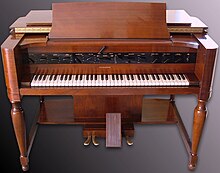Novachord
| Novachord | |
|---|---|

Hammond Novachord
|
|
| Manufacturer | Hammond |
| Dates | 1939–1942 |
| Technical specifications | |
| Polyphony | 72-voices |
| Oscillator | Divide-down |
| LFO | 6-channel electromechanical vibrato |
| Synthesis type | Subtractive analogue |
| Filter | 3-stage resonant bandpass |
| Input/output | |
| Keyboard | 72-notes |
The Novachord is often considered to be the world's first commercial polyphonic synthesizer. All-electronic, incorporating many circuit and control elements found in modern synthesizers, and using subtractive synthesis to generate tones, it was designed by John M. Hanert, Laurens Hammond and C. N. Williams, and was manufactured by the Hammond company. Only 1,069 Novachords were built over a period from 1939 to 1942. It was one of very few electronic products released by Hammond that was not intended to emulate the sound of an organ.
While production of the Novachord began in November 1938, it was first heard at the 1939 New York World's Fair. The Novachord Orchestra of Ferde Grofé performed daily at the Ford stand with four Novachords and a Hammond Organ. The first instrument was delivered to President Franklin D. Roosevelt on January 30, 1940 as a birthday present.
The Novachord was not well-suited to the technique of organists or pianists and required frequent adjustments to controls on the front panel to create new sounds. Like many analog synthesizers, it was much better-suited to producing "otherworldly" timbres. The instrument found its niche some years after production, shaping the sound of many science fiction film and television scores.
Production stopped because of a shortage of parts in 1942 and poor sales kept it from being built after the war. It is estimated that fewer than 200 Novachords are still in existence and considerably fewer are still in operation. The vast majority of surviving examples are in North America, although one is known to be in the United Kingdom.
Containing 163 vacuum tubes and over 1,000 custom capacitors, the Novachord weighed nearly 500 pounds and was roughly the size of two spinet pianos. The divide-down oscillator architecture, based on vacuum-tube monostable circuits, permitted all 72 notes to be played polyphonically by deriving several octaves of notes from twelve top-octave oscillators. A similar design was adopted in polysynthesizers released more than 30 years later by Robert Moog and A.R.P.
...
Wikipedia
